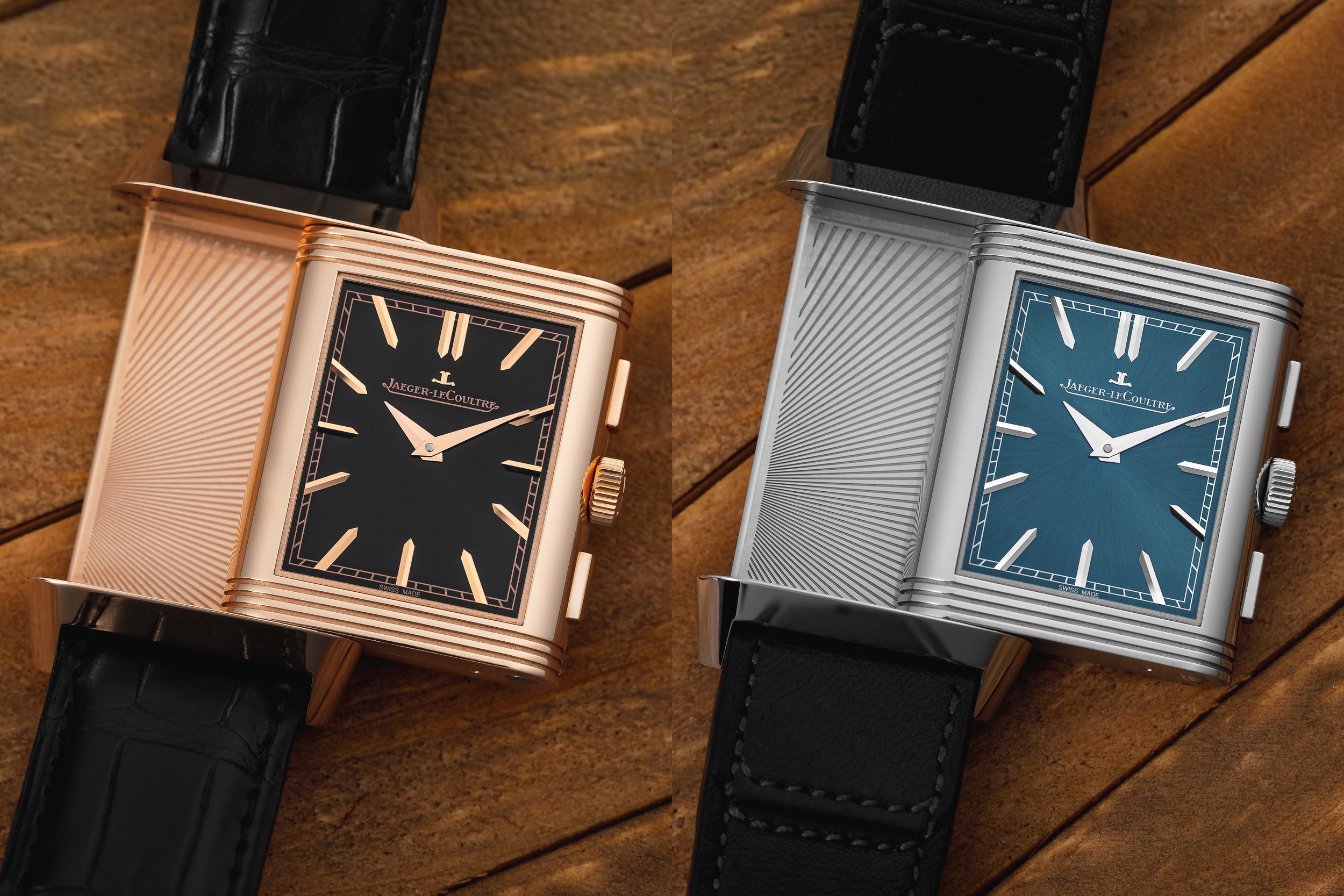Hands-On Jaeger-LeCoultre Reverso Tribute Chronograph Review
The Jaeger-LeCoultre Reverso is an icon. First released in 1931, most of us know the story of its origins. Created with the intention to withstand the rigors of Polo, the aptly named Reverso’s case could be flipped during a match to protect the dial and crystal from harm. On these earliest models, when the the case was flipped, only a steel closed back would be visible. And while the “monoface” models, as they have come to be called, are still produced today and most accurate to the original models, Jaeger has expanded the lineup by creating duoface models.
The duoface Reversos are still quintessentially Reversos, but yet are not meant to withstand the rigors of polo. That is because instead of a stainless steel reverse side on these models, they instead have another dial, with a second time zone and other complications. With the duoface, you get a little more “bang for your buck” as you can have two very different styles in one watch.
That brings me to the Reverso Tribute Chronograph. Released at Watches & Wonders 2023, it might be my favorite release of the last year. And I have been eager to review the Tribute Chronograph for as long as it has existed. After seeing one in person for the first time last month during JLC’s Reverso Stories Exhibition in New York City, I made it a point to get my hands on both the gold and steel models for review. And I was definitely not disappointed.
First let me state that, that while the Reverso Tribute Chronograph may not technically be a Duoface, because it only displays one time zone, the spirit of the Duoface is definitely present. While time is displayed on both dials, it is displaying the same time zone, set simultaneously through the crown. This doesn’t bother me, as both dials could not be more different (more on that later).
On both the stainless steel and pink gold models of the Tribute Chronograph, the “main dial” is a pretty standard affair. Playing into the heritage of the line, the sunray dials are understated and fit the art deco style of the case. Both models have applied metal indices and metal hands without any lume plots.
On the stainless steel model, the sunray dial is a light blue. To me, this, along with the steel case, makes the watch look a little bit more modern. The hour markers are steel and this side of the dial is very legible. The blue of the dial is incredibly unique, not playing into any of the current fads, such as turquoise dials and deep blue dials (like on the Audemars Piguet Royal Oak and Patek Philippe Nautilus). Instead, the blue is more muted and has hints of grey.
On the pink gold model, JLC opted for a black sunray dial with gold applied indexes and hands. To me, this is a much more traditional, art deco, style. And while I like the look very much, it seems a bit dressier to me.
However, when you flip the case over, you are greeted by something completely different, a skeletonized dial with chronograph. As mentioned earlier, the time display is the same on both watches. There is a single movement in the watch, and both dials show the time running in the same direction. So essentially, on the skeletonized dial side, the hands are running backwards. This might be a feet more impressive then including two time-zones in one movement.
The skeletonized dial is more than just an openworked dial. The watch’s complication, a chronograph, is featured on this side of the dial. The chronograph on both the gold and steel models is unique, as is required by the rectangular shape of the case. The chronograph’s seconds hand is centrally mounted, with indication through mid-case 60 second disc. At 6 o’clock there is a semicircular retrograde 30 minute chronograph subdial. After the chronograph reaches 30 minutes, it will jump back to zero.
When operating the chronograph functions, the pushers will be on the left side of the case (as opposed to the usual right side of the case). This is because the pushers are on the right side of the case when the time only is displayed. This seems indicate that Jaeger considers the time only dial is the main dial, and they did not want to separate the chronograph pushers from the (like on the original TAG Heuer Monaco).
The skeletonized dial on both the gold and steel models is stunning, and truly a conversation starter. Even though the watch is just 11mm thick, there are so many depths to the openworked dial. On the steel model, the watch skeletonized dial is a bet less legible, since the hour markers and hands are the same color as most of the movement. I have no problem with this, because if you want legibility, you can just flip the dial over to display the time only dial. The chronograph seconds and minutes hands are both blue, which gives the needed legibility when operating the chronograph.
The skeletonized dial on the pink gold model is much more legible, as the hands and indexes are both pink gold. This contrasts with the steel movement, and offers a lot of contrast. Like on the steel model, the chronograph hands are blue and the seconds and minutes discs are black (but with a gold trim on the gold model). When wearing both models, I found myself showcasing the skeletonized dial most often, because to me, that’s what makes the watch so interesting. Though, when I was in crowds, or walking down a Manhattan street, I flipped the case over, so to not draw as much attention to myself or my wristwear.
On the wrist, the Reverso Tribute Chronograph wears a little bit larger than most of the other Reversos in JLC’s catalog. At 29.9mm in diamater and 49.4mm lug-to-lug, it wasn’t exactly small on my 6.75 inch wrist, especially since square and rectangle watches wear larger on your wrist. So you should take note, if you are thinking about purchasing. But, with the amount of engineering and functionality you get in this watch, I understand why it has to be larger. I am not sure how JLC would be able to size down this watch, include the and still make the watch legible.
The Tribute Chronograph is powered by a brand new movement, the in-house Manufacture Calibre 860. This movement is manually wound has a power reserve of 52 hours and beats at 4 hz.
Often referred to as “the watchmaker’s watchmaker”, the Reverso Tribute Chronograph is the perfect distillation of Jaeger-LeCoultre as a brand. The time only dial represents the classic and understated side of the brand, while the skeletonized dial represents the brand’s ability to create beautiful, yet complicated, watches (such as the Duomètre Sphérotourbillon or the Reverso Quadriptyque).
You can pick up the Reverso Tribute Chronograph in stainless steel for $25,000 USD and the pink gold model for $38,800 USD.




















